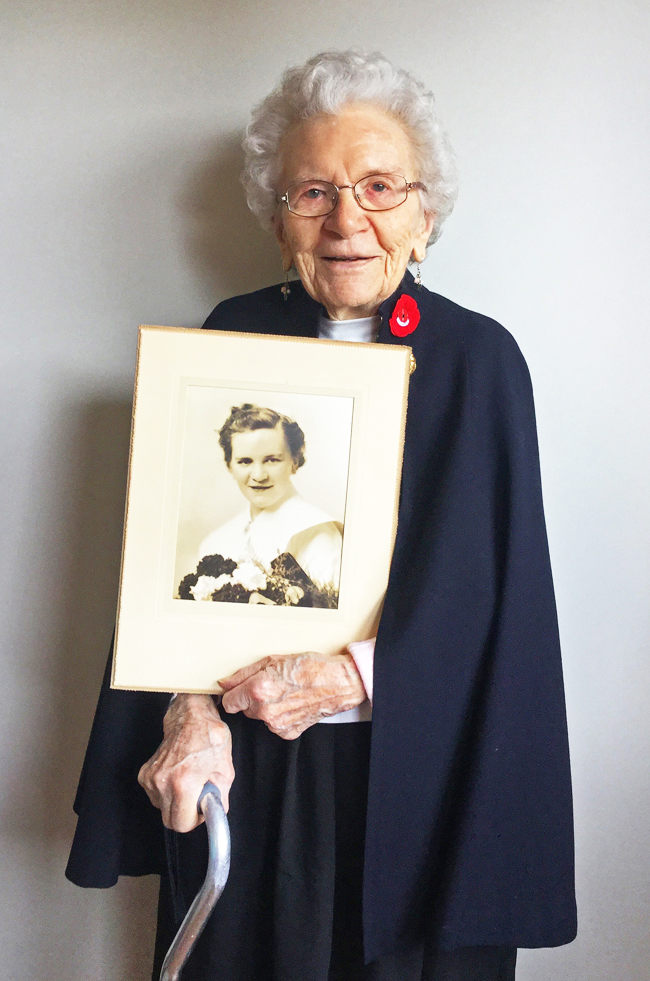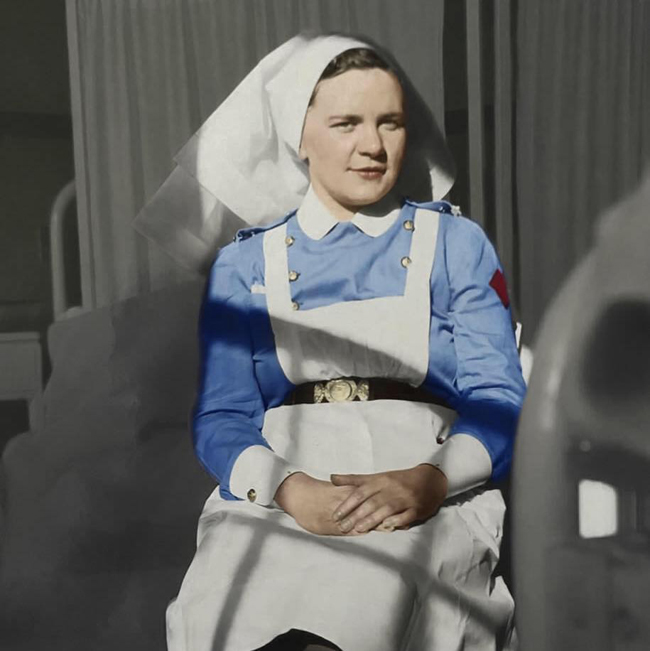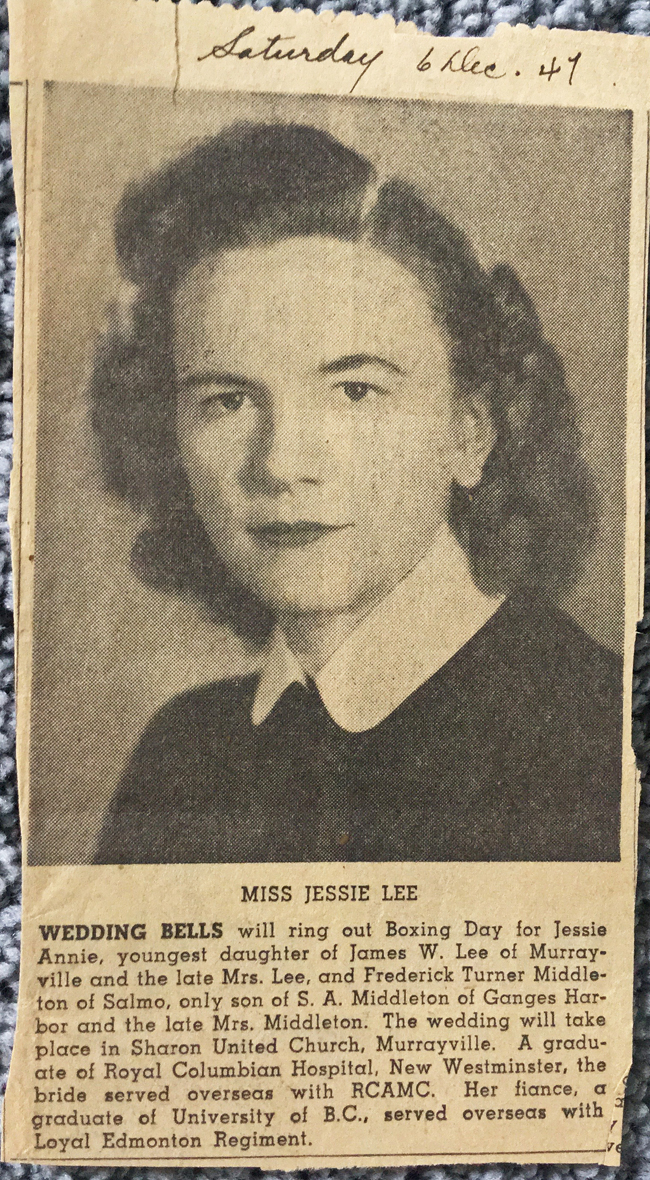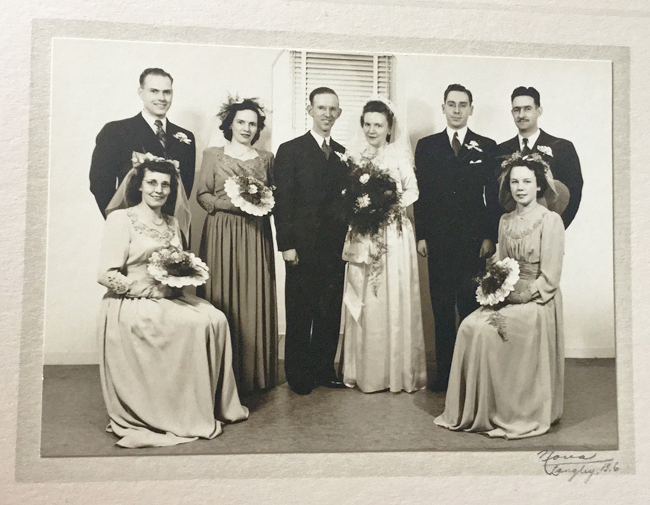My admiration is boundless when it comes to the Canadian wartime nurses who bravely carried out their grim duties — so it was an honour to interview Jessie Middleton of Abbotsford, British Columbia.

I was especially keen to meet Jessie because my column has not paid enough attention to wartime nurses — our Canadian women in uniform who were the next best thing to angels.
(Note: Jessie passed away on May 22, 2019 at the age of 102 years. Rest in Peace, Jessie Lee Middleton.)
* * * * * *
History of Wartime Nurses
Military nursing in Canada began as early as the 1885 Northwest Rebellion. Our nurses followed the soldiers to the Boer War in South Africa, and then again to France in World War One.
When World War Two began, nursing sisters once again answered the call. This time, however, the nursing service was expanded to all three branches of the military: navy, army and air force.
Each branch had its own distinctive uniform and working dress, while all wore the traditional white veil. They were respectfully addressed as “Sister” or “Ma’am,” because all were commissioned officers.
By war’s end, 4,480 nursing sisters had enlisted, including 3,656 with the Royal Canadian Army Medical Corps, 481 with the Royal Canadian Air Force Medical Branch, and 343 with the Royal Canadian Naval Medical Service.
* * * * * *
Jessie Lee’s Family Background
When I was contacted a couple of months ago by Jessie’s granddaughter Amanda Morganton asking me to interview her grandmother, I jumped at the chance. At the age of 98, Jessie had recently moved into an assisted living facility. Since I was passing through Abbotsford, I interviewed Jessie in her new home.
(The following account is based on a personal interview, plus files from an article written by Warren Sommer for the Langley Times, dated November 7, 2013.)
I found Jessie Lee Middleton to be a gracious and elegant lady, with the dignified bearing that carried her through the horrors of war. You can see this quite clearly in her photograph at the top of this page.
Jessie Annie Lee was born on December 12, 1916 in Murrayville, B.C., the twelfth and last child of farmer James Lee and his wife Edith Brown. When she was born, two of her older brothers were fighting the Germans in the trenches of France. She grew up in Murrayville and attended high school in nearby Langley, B.C.
Here’s the entire family — what an attractive group! The “baby” of the family, Jessie, is in the back row, second from the left.

* * * * * *
Jessie Trains as Nurse
In those days girls who wanted a career were told to become either a teacher or a nurse — fortunately, it wasn’t a difficult decision for Jessie, who had always wanted to nurse.
Her desire was fuelled by the death of her baby nephew George in 1924, a tragedy for the Lee family. She enrolled in the Royal Columbian Hospital’s nursing program in New Westminster, B.C. This was a rigorous three-year program taught by “old school” doctors and nurses.
In her third and final year, the trainee nurses cared for tuberculosis patients at the Tranquille Sanatorium in Kamloops, B.C. The nurses’ residence is shown here in this old photograph.

Jessie remained in Kamloops for about three months and stayed over Christmas 1938. You can see the decorative woodwork of the sanatorium wall behind this group of Jessie’s classmates.

Eight months later, she graduated in September 1939 — one day after Canada declared war on Germany again. The country was in a state of high anxiety as Canadians girded themselves for yet another war. This is Jessie’s graduation photograph.

* * * * * *
Jessie Begins her Nursing Career
Although she wanted to join the army straightaway, she was only twenty-two years old at the time, and she had to wait until she was twenty-five. I asked her why other women were able to enlist at a younger age, but not nurses.
Jessie paused for a moment, and then answered: “Not to take any value away from the others, but we nurses had a great deal of responsibility.” I understood what she meant when she described her duties overseas.
She began her nursing career in the maternity ward at Vancouver General Hospital. Some of her patients were Japanese women, interred as enemy aliens in the old horse barns on the Pacific National Exhibition grounds, and brought into hospital to deliver their babies.
* * * * * *
Jessie Becomes Lieutenant Lee
Jessie was finally able to enlist in 1942. What a proud moment that was for her! This certificate says that J.A. Lee is now a Lieutenant in the Royal Canadian Army Nursing Corps.

Commissioned as Lieutenant Nursing Sister Lee, Jessie was first posted to a hospital in Nanaimo, on Vancouver Island, where most of her cases were caused by training accidents or illnesses. “People got sick, you know, even in the army,” she said. Here’s the General Hospital in Nanaimo, now a historic site.

A few months later, she was posted to a military hospital in Prince Rupert, B.C. on the northern coast. The community did its best to protect itself against a feared Japanese invasion.
“There were high searchlights placed at the entrance to the harbor, and a net across the harbor to stop the submarines. When the ships came in, they turned off their propellers and drifted across it.”
Jessie spent six months there. “This was my first real experience of army nursing.” Here’s Jessie on the left with friends Mary Dowie and Queenie Rutherford.

* * * * * *
Jessie Posted Overseas
Like every other Canadian woman in uniform, Jessie longed to go overseas. Finally she received her marching orders. She came home to Murrayville for a week’s leave, and although she hadn’t mentioned a word about where she was headed, her mother suspected that Jessie was leaving the country. “Mother smelled a rat!”
Jessie joined a continent of wartime nurses being sent overseas in March 1943. She was mobilized at Camp Sarcee in Calgary, and here’s a photo taken just before she left Canada.

* * * * * *
Jessie Nurses Wounded Men in England
It was a long, arduous journey. Jessie took the troop train to Halifax, and boarded the waiting ship that bore them to Greenock, Scotland.
The Queen Elizabeth luxury liner was crammed to the gunwales with thousands of enlisted men. Due to the lack of space, the men spent twelve hours every day on deck, where it was cold and damp. Fog condensed on their woollen blankets, and pneumonia set in.
“Some of them never set foot on English soil — they were carried ashore on stretchers and sent straight back to Canada.” Jessie and the other wartime nurses then travelled by train to Horley, south of London.
Jessie was assigned to the No. 7 Canadian General Hospital at Taplow, on the Astor estate, just west of London on the Thames River. There she saw terrible combat injuries for the first time.
“We had one patient — he was recuperated, he was healed — but his face had been burned. If you can imagine it, his eyes, nose, all those parts were gone. He had no ears. He went and hid the day the Queen came to visit our hospital.”
(The Queen’s visit was a highlight of her ten months at Taplow — Her Majesty visited the wards and had tea in the nurses’ residence.)
Shell shock was not uncommon. The frequent sound of the big Allied bombers leaving at sundown to bomb German targets, and returning early the next morning, was particularly upsetting for some patients. “Once they’d hear a plane overhead, they’d go berserk,” Jessie said.

* * * * * *
Jessie Joins the Medical Corps in Italy
But Jessie’s skills were required even closer to the front. The Allies had taken Sicily the previous year, but had lost 562 Canadian soldiers during the fierce fighting. “The Canadian Army was going up the boot of Italy very, very quickly,” she said. Nurses and doctors were needed to treat the wounded.
In mid-summer, she left Liverpool in a convoy with a dozen other ships. “One morning we woke up in the Mediterranean Sea, and the convoy was gone.”
On July 31, 1944 she arrived in Avellino, a historic town on a plain northeast of Naples, and began to nurse the wounded in a field hospital. The hospital locations chosen were as safe as possible, although they had to be accessible from the front lines. The field medics stabilized the wounded soldiers on the battlefield, and sent them back to the hospital by ambulance.
“They would find us a building that would do for us, and then they’d find a better one a few miles up. They were extremely efficient. They needed a site that would accommodate 300 beds, for example, plus they assigned so many doctors and nurses and medics for each hospital.” One hospital, she recalls, was a big old Italian abbey. Here’s a photo of Jessie in the dark shirt, and one of her fellow wartime nurses, on the steps of a field hospital.

Her work led her north to Jesi, an ancient town near the Adriatic port of Ancona. The war was being waged just a few dozen miles to the north, and the effects were staggering. “Ancona was horrible — hardly a brick left on a brick. Sometimes it did get to you.”
She occasionally had leave, and was able to visit cities recaptured by the Allies, including Rome, Florence, and Pisa. She remembers having a picnic on top of the Leaning Tower of Pisa, eating bully beef sandwiches!
“We would share our food packages from home with the Italian civilians. One thing they particularly loved was fish!” This photo from Jessie’s album shows her with a couple of Italian farmers.

* * * * * *
Jessie Transferred to Holland after D-Day
While the campaign in Italy wound down, Jessie and her fellow wartime nurses were dispatched to northwest Europe, where the fighting was even fiercer. After the D-Day invasion on June 6, 1944, Canadian troops were battling their way through the Netherlands.
Assigned to a hospital in Nijmegen, Holland, Jessie was closer to the fighting than she had ever been. “The first few nights we heard the sound of battle all the time. They had an attack of gliders. We saw them in the fields where they landed. They were just targets, parachutes caught in the trees. The men were helpless. The Germans would just shoot them.”
As the battle raged, the parade of wounded seemed endless. “They came all night long. They would come up those stairs, clump, clump, clump, and to the beds.”
Sometimes German prisoners were treated by the wartime nurses along with the Canadians. There was a reciprocal agreement that the patients would be exchanged when they were well enough.
“They were just patients, never an enemy,” Jessie said. “I remember one young German boy. I swear he must have been 15. He had an abdominal wound . . . he was to have nothing by mouth. And you’d turn your back, and he’d somehow gotten a little something from someone else’s table. But he was a lovely little fellow, blond, blue-eyed. He was mischievous. It was just a lark for him.”
For the most part, the duties of wartime nurses were tragic and emotionally draining. “Every once in a while we would have one who was badly, badly wounded and was not going to survive. You just had to let them die. It was miraculous that their heart was still beating, but there was no way to lead them out of their misery. They’d just lie there till they died. You’d keep their mouths moist; there was nothing else you could do.”
Jessie paused again, clearly emotional.
“Some of them were so seriously wounded that they couldn’t be moved, and we became quite fond of them. They were only kids. The thing to me that hurt so much, was that they were so young.”
She repeated: “They were so young.”
* * * * * *
Victory at Last!
Jessie remembers the day the long war ended. “We had either gone to a show or a party or something. We came out of that building and they were snake-dancing through the town. The lights were on! I thought they had to be crazy! What has happened? Of course, I couldn’t believe that peace had come. It seemed like it would never come.”
Jessie spent two months at Oldenburg, Germany, before sailing back to Canada on the Rotterdam. She enrolled in the nursing program at McGill University and began dating Frederick Turner Middleton of Salmo, B.C., a veteran of the Loyal Edmonton Regiment. They had met during the war, and now it was time to get serious. The young couple became engaged.

The happy event took place on Boxing Day 1947, in Murrayville, B.C.

* * * * * *
Jessie’s Life After the War
Jessie gave up nursing when she married, and became a devoted wife to Fred and mother to two children: Kathleen Middleton McGillivray of Surrey, B.C.; and Bob Middleton of Creston, B.C.
Fred’s position as a school superintendent took them to several locations around the province, and then to Abbotsford in 1974.
Her daughter Kathleen and husband Bruce McGillivray live in Surrey, B.C. They have one daughter named Miracle. Jessie’s son Bob and his wife Anita Shirley Ross Middleton live in Creston, B.C. They have three children: James, Allan, and Amanda.
Jessie’s husband Fred died in 1982. She lived in the same house for forty years, until moving to a nearby nursing home. For many years she put her training to good use by volunteering with the Abbotsford Hospice Society.
On July 18, 2012, Jessie Lee Middleton was presented with the Queen Elizabeth II Diamond Jubilee Medal for her service to her country.
Thank you so much, Jessie, for your kindness and compassion, and the personal sacrifices you made on behalf of our Canadian soldiers. God bless and keep you.



